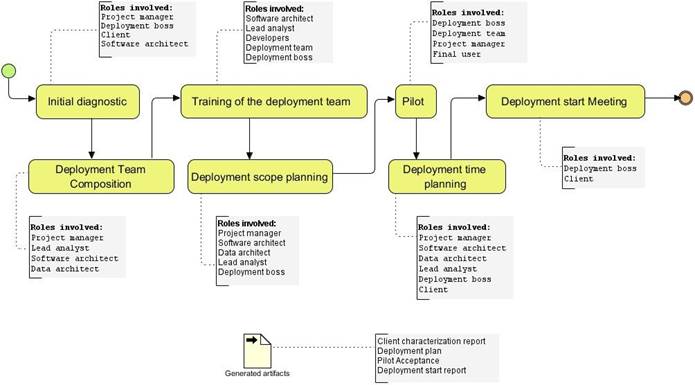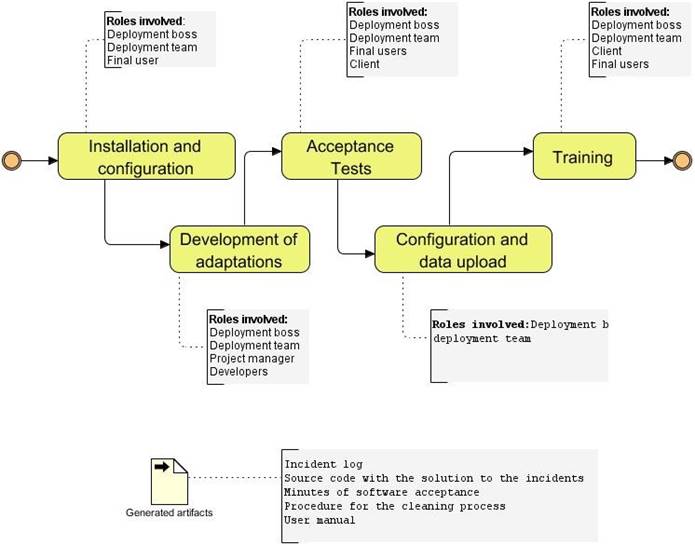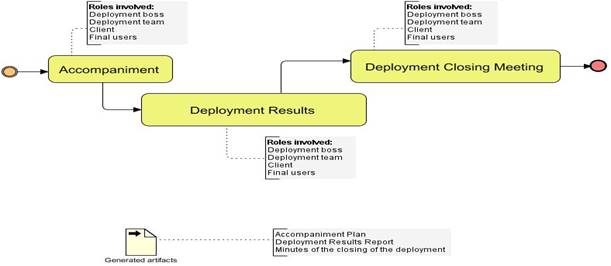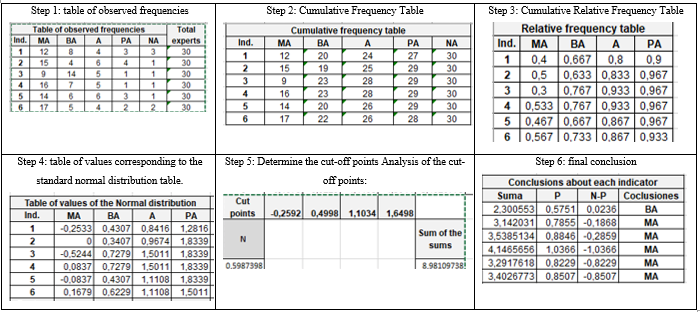Introduction
Information Technologies and Communication (ICT) are at an accelerated pace in the current development of contemporary societies. The software development process within ICT is not an easy task (Ríos et al., 2018), as multiple activities are developed. It must be done with quality, and as Juran (Breitkreitz, 2021) states, quality does not happen by chance, it must be planned. Every day companies concentrate their efforts on providing IT solutions that focus on the quality of their processes to generate value in a competitive market so during software development it is important ensure it at all stages, and the deployment is not exempt from it.
Rational Unified Process (RUP) (Shafiee et al., 2020), defines deployment as a workflow, which aims to successfully produce distributions of the product and distribute it to users. Deployment is when the software (as a complete entity or as a partially completed increment) is delivered to the consumer who evaluates it and gives feedback. Deployment is the time to offer customers quality products, reducing their costs and increasing their productivity. It is important to dimension the resources to be able to provide the necessary assistance to the deployment, which is so critical and not always very evident. It is an expensive and complex stage (Rivera, 2011), which is not always given due attention. The deployment ceases to be a merely technical process, to become a complex and rigorous process.
During the investigation, interviews and bibliographic reviews were carried out to characterize the context in which the proposal is made and to define how the scientific problem arises and develops. The experiences of deployments that have been carried out were studied. In addition, interviews and focus groups were applied to establish the set of recommendations that can affect the success of the proposal, as well as to define critical routes for its implementation.
In general, different sources of information were consulted, including standards, methodologies, specialized journals, conference proceedings, master's and doctoral theses. To limit the domain of the research, search equations were used with terms specific to the topic to be investigated, such as deployment, start-up, transition, and electronic government. From these searches, selectivity criteria were applied to use only relevant documents for the investigation. The analysis of the collected information allowed to make practical and theoretical conclusions of the investigation.
Methods
In the present investigation, theoretical and empirical scientific research methods are used. The methods used are referenced below:
theoretical methods:
the historical-logical (Torres-Miranda, 2020) method was used for the critical analysis of previous works with the aim of establishing a point of reference for the resulting proposal.
the hypothetical-deductive (Vera Solórzano, 2020) for the elaboration of the research hypothesis and the proposal of the research line of work.
the analytical-synthetic (Falcón y Serpa, 2021) for the decomposition of the research problem into elements that allow its deepening, to later synthesize them in the proposed solution.
the modeling (Haza y Véliz, 2019) for the representation of the proposed solution.
empirical methods:
the survey (Avila, González y Licea, 2020) to obtain the assessment of the experts regarding the contribution of the proposed procedure in the solution of the research problem.
the criteria of experts (Ramírez et al., 2022), for the validation of the fundamental contributions of the research.
the experimental (García-Argüelles et al., 2018) method to check the usefulness of the results obtained from the implementation of the procedure.
Results and Discussion
In order to talk about quality, a great historical process had to be generated that is constantly evolving, such as Software Development Methodologies. These propose as main objective to present a set of traditional, modern and agile techniques for modeling systems that allow developing quality software (Montero, Cevallos et al., 2018) .
Table 1 Deployment in methodologies.
| Methodology | Deployment |
| Integrated Maturity Capability Model ( |
It is a process model that contains the best industry practices for the development, maintenance, acquisition and operation of products and services (Chavarria, Ore et al., 2016) |
| Unified Development Process |
It is the moment in which the product is produced and the software is delivered to end users in the RUP methodology (Metzner and Niño, 2012) . |
| Development Methodology for the Productive Activity of the UCI ( |
It is seen as an optional discipline, which constitutes the installation, configuration, adaptation, start-up of computer solutions and training for client personnel (Garay and Soto, 2016) . |
Source: self made.
As can be seen in the analysis of the proposed methodologies, they expose several phases and processes in the realization of the product and although the activities carried out in each of them are different, their primary objective is to provide users with a well-made product. and with quality. They raise only in a general way, the activities to be carried out during the period of deployment or implementation of a product. They are not very descriptive in terms of deployment, so their execution depends on the experience of the specialists, allowing the omission or occurrence of additional steps that may affect the implementation of the system. No steps or processes are disclosed to carry out the organization of a deployment, the activities proposed in these methodologies do not include, nor do they facilitate, the formulation of strategies to plan and organize a successful implementation.
International studies on software deployment are marked by a small number of generic publications that cover deployment for its general implementation in software products. In “ Software deployment, past, present and future” (Dearle, 2007) treating deployment as a post-production activity, specific implementation issues are examined before looking at some of the future directions the field of implementation might take. In the last five years the theme has focused on more specific environments to solve a specific problem:
Software deployment on heterogeneous platforms: A systematic mapping study (de Andrade, Schroeder et al., 2019)
Definition of risks for the software systems deployment process (Ortiz, 2021)
design and deployment of a generic software for managing industrial vision systems (Banús, Boada et al., 2021)
Deployment of software systems: state of current practice in SMEs in Argentina (Panizzi, Hodes et al., 2021)
At the national level there are also articles related to the subject, specific to certain areas:
Technological compatibility in the deployment of business management systems (Capeáns Hurtado and Rodríguez Puente, 2015)
Procedure for the security of the web application deployment process (Hernández Yeja and Future Rubier, 2016)
Initial proposal for the improvement of the deployment stage in the Electronic Government Center (Galvez and Perdomo, 2021)
After the international and national study, it is determined that the works consulted do not show a strategy, procedure or other instrument that allows carrying out the deployment of software in management systems. In studies carried out on management systems, they showed that the deployments were carried out based on the previous experiences of the different development teams, a defined instrument that could set the guidelines for carrying out the deployment was not followed. These characteristics of the deployments brought with them errors that influenced their unsuccessful results:
Not having defined objectives.
Poor change management.
Software packages that do not cover basic needs.
Misconfiguration, initial load and data migration.
Insufficient training in the system and in new processes.
Technological incompatibilities.
These deficiencies make it impossible to comply with the estimated times, raise costs and reduce the quality of the process. In addition, they generate instability and low staff specialization (Rivera, 2011).
The technology deployment and transfer processes are among the most costly and complex within the project life cycle due to the high number of external factors that influence it, the number of personnel required, the direct participation of end users and the volume of work that demands the adaptation and support of the software in real conditions (Rivera, 2011). Software deployment is usually an intensive process, in some cases, repetitive and with a high probability of committing errors, because in most cases it is done manually by system operators and the number of actions to be carried out is high. (Hernández Yeja & Porven Rubier, 2016).
The main objective of the research reflected in this article is to provide specialists with a way that allows the successful execution of the processes and activities involved in software deployment. This procedure is made up of three processes (Planning, Implementation and Start-up), each of which is made up of activities, where different roles are involved and various artifacts are generated. Figure 1 below depicts the planning process graphically:
Font:. Own elaboration
Fig.1- Planning Process
After this process comes the Implementation, which is described graphically below:
Font: Own elaboration.
Fig. 2- Implementation Process.
Continue the procedure with the start-up process:
Font: Own elaboration.
Fig. 3- Commissioning Process.
In each of the activities carried out during the deployment stage, artifacts are generated that are outputs and, in turn, constitute inputs for the different proposed activities.
Table 2 Planning Process.
| Process : planning | |||
|---|---|---|---|
| Description: this process is carried out after the negotiation between both interested parties (developer entity and client entity). At this point, deployment planning begins. | |||
| Activities | Name | Description | Roles involved |
| 1 | Initial diagnostic | An initial diagnosis is made to know the state of the institution from the technological point of view. This way you have a starting point for deployment. |
Project manager Deployment boss Client Software architect |
| two | Deployment Team Composition | the people needed to carry out the deployment are identified. The staff that will be counted on for its development requires proficiency in the work of computer tools and a basic knowledge of the business of the place where it will be deployed. |
Project manager Lead analyst Software architect Data architect |
| 3 | Training of the deployment team | The personnel who will carry out the deployment are prepared through training. These training sessions are aimed at transmitting knowledge about the business of the system to be deployed. |
Software architect Lead analyst Developers Deployment team Deployment boss |
| 4 | Deployment scope planning | the scope of the deployment is planned, that is, the number of machines where it will be deployed and people who will interact with the software |
Project manager Software architect Data architect Lead analyst Deployment boss |
| 5 | Pilot | it is a kind of small deployment, where the activities described above are carried out from one to four. The results of the pilot will make it possible to determine the real situation in terms of the technology and to make an evaluation of the time that the deployment could last. |
Deployment boss Deployment team Project manager Final user |
| 6 | Deployment time planning | the time of each of the activities of the procedure that make up the deployment is planned. In this way it will be possible to determine the time the deployment will have. |
Project manager Software architect Data architect Lead analyst Deployment boss Client |
| 7 | Deployment Kickoff Meeting | The deployment start meeting is held where the guidelines and conditions for carrying out the deployment will be made clear. |
Deployment Chief Client |
|
Generated artifacts: Customer characterization report deployment plan Pilot Acceptance Deployment start report | |||
Source: Own elaboration.
After the planning is done, it is time for implementation.
Table 3 Implementation Process
| Process : implantation | |||
|---|---|---|---|
| Description: This process is executed after having carried out the activities of the planning process and having generated the corresponding artifacts. In this process, the software that has been developed reaches the client and during it the necessary adaptations are made to the real environment where the software will be. | |||
| Activities | Name | Description | roles involved |
| 1 | Installation and Configuration | the installation and configuration of the software developed in the client entity is carried out. For this, it must be taken into account if the installation will be implemented for use in a single entity or in a massive way. |
Deployment boss Deployment team Final user |
| two | Development of adaptations | During the installation and configuration process, incidents can be detected that make it impossible for the software to work, which must be resolved to continue with the deployment. |
Deployment boss Deployment team Project manager Developers |
| 3 | Acceptance Tests | At this time, the software is tested by the users and the client, to confirm that the implemented software meets the required specifications. |
Deployment boss Deployment team Final users Client |
| 4 | Configuration and data upload | All the necessary configurations are made with the data load that the software needs for its operation. |
Deployment boss Deployment team |
| 5 | Training | the knowledge held by the software deployment team is passed on to the end users of the software. It is carried out through theoretical and practical actions. |
Deployment boss Deployment team Client Final users |
|
Generated artifacts: Incident Log Source code with the solution to the incidents Minutes of software acceptance Procedure for the cleaning process User manual | |||
Source: Own elaboration.
After the implementation is done, it is time to start up.
Table 4 Start-up process.
| Process : commissioning | |||
|---|---|---|---|
| Description: This process is executed after having carried out the activities of the implementation process and having generated the corresponding artifacts. In this process, the software begins to be exploited by end users. | |||
| Activities | Name | Description | roles involved |
| 1 | Accompaniment | The deployment team accompanies the end users in the use of the software, during the time that has been established by mutual agreement between the two parties. During this period end users will be using the system. |
Deployment boss Deployment team Client Final users |
| two | Deployment Results | All the incidents that occurred during the deployment are collected in a detailed report, as well as the solutions provided to them. All the artifacts generated during each of the activities that make up the processes of the deployment procedure are attached to this document . |
Deployment boss Deployment team Final user Client |
| 3 | Deployment Closing Meeting | It is the last activity that is carried out during the deployment, it is the moment where the conclusion of the deployment is signed, giving way to the support stage. |
Deployment boss Deployment team Client Final users |
|
Generated artifacts: Accompaniment plan Deployment Results Report Minutes of the closing of the deployment | |||
Source: Own elaboration.
In this way, each one of the activities of the procedure is described, with the artifacts generated and the roles that intervene at each moment. To corroborate its relevance, it is validated through expert criteria.
Validation of the proposal.
For the validation of the proposal at first it is done through the application of the Delphi method. In (Crespo Borges, 2007) it is stated that expert criteria are preferably applied when situations such as:
There is no historical data to work with.
The impact of external factors has more influence on evolution than that of internal ones.
In the application of the method, it was taken into account that the specialists have worked on software projects for at least five years, so that they are involved in the deployment stage within the projects in which they worked. In this way they will have elements to contribute, recommendations to make and insufficiencies to detect in the proposed procedure. For the selection of the experts, the following were taken into account:
The areas of knowledge to be mastered by the experts that are part of the method, in this case deployment within software development.
Prepare the list of candidates who present conditions based on the evaluation of the previous point.
Obtain the participation of experts who meet the two previous points.
Calculate the coefficient of expertise through a self-assessment. (Rodríguez Perón, Aldana Vilas et al., 2010)
Table 5 Assessment of the level of competence of the experts.
| sources of argument | Degree of influence of each of the sources on their criteria. | ||
|---|---|---|---|
| Tall | Medium | Bass | |
| Theoretical analyzes carried out by you | 0.3 | 0.2 | 0.1 |
| Your experience gained | 0.5 | 0.4 | 0.2 |
| Works of national authors | 0.05 | 0.05 | 0.05 |
| Works of foreign authors | 0.05 | 0.05 | 0.05 |
| Your own knowledge of the status of the problem abroad | 0.05 | 0.05 | 0.05 |
| your intuition | 0.05 | 0.05 | 0.05 |
Source: Modified from (López R., 2016).
After the application of the formula to calculate the level of competence of the experts, it was possible to obtain that thirty specialists of the respondents met the condition of expertise for the validation of the procedure.
For the processing of the data obtained, the pairwise comparison method was used, which consists of several steps:
Indicator one (1): Pertinence of the procedure was evaluated in the category of Quite Adequate. For indicators two (2): Objective of the procedure, indicator three (3): Foundations assumed, indicator four (4): Structure of the procedure, indicator five (5): Methodology for its execution and indicator six (6): Preparation of the specialists were evaluated in the category of Very Adequate.
Among the criteria issued by the experts who responded to the survey, the following positive elements are pointed out:
Inclusion of the client and end users in the different activities described in the deployment strategy.
Artifacts generated in each of the activities.
As a result of the validation of the procedure, its contribution to the solution of the research problem is confirmed. The above statement is verified in the level of acceptance of the experts regarding the deployment procedure.
Conclusions
Software deployment is the process that allows the work carried out during a given period to be brought to the end user. This procedure is the path to follow for the development of software deployments. This procedure does not define what to do, it only proposes aspects to take into account and what must be considered in each of them, as well as the roles that must intervene in each of them.
The consultation and study of different bibliographies such as journal articles, master's and doctoral theses, articles from events and symposiums, among others, allowed determining essential elements for the conformation of the proposal. The study of the CMMI model, followed and certified by the UCI for its development process at level II and study of the methodologies used, made it possible to determine the scarcity of clearly defined activities to carry out the deployment stage with the highest possible quality. .
This initial proposal provides a specific procedure for the deployment stage, it was validated using the Delphi method, obtaining opinions and suggestions from the experts who participated in the validation.


















